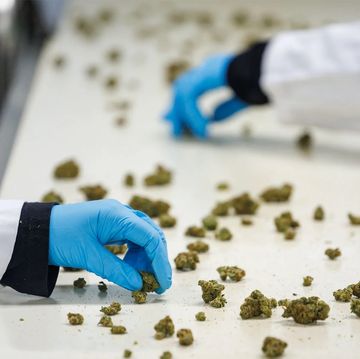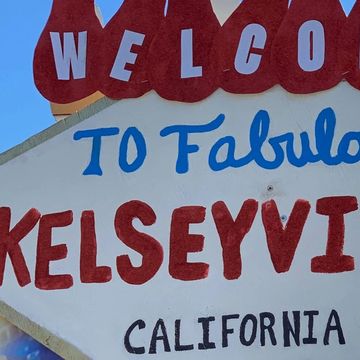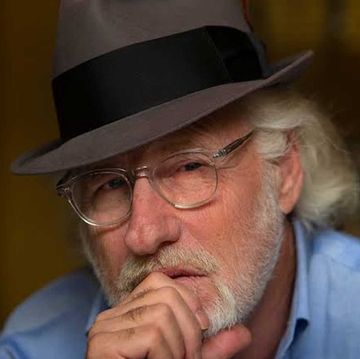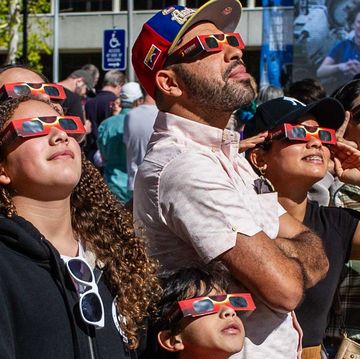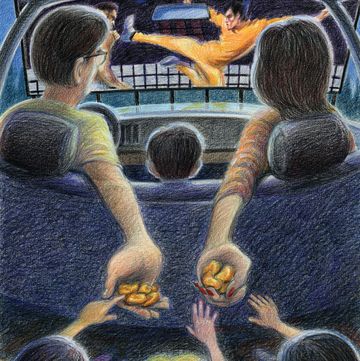Back when my main day job was playing the saxophone at gigs, I picked up a copy of critic Oz Clarke’s snobby yet engaging The Essential Wine Book to prepare for a vino-fueled music tour of Australia. A mere quarter of a page in the Eurocentric bestseller was devoted to Mexico’s wine region. But as it turns out, that tiny sliver changed my life.
It was 1999, and a quiet viticulture revolution was happening just a short drive from the tourist bars of Ensenada, in a region of northern Baja known as Valle de Guadalupe. The area was anchored by boutique Mexican wineries that had emerged in the prior two decades, like Viña de Liceaga (’83), Mogor Badan (’87), Monte Xanic (’88), Château Camou (’95), and the influential Casa de Piedra (’97). When I first made it down to the region, in 2000, there was only one modern-Mexican farm-to-table restaurant, Laja. “All there was to eat was huevos rancheros before I opened here,” says chef Jair Téllez, who founded Laja in 1999.
This article appears in Issue 26 of Alta Journal.
SUBSCRIBE
Over the next decade, other seasonal restaurants would pop up, and there were enough solid wineries to make for a lazy day of tastings over bumpy dirt roads that often led nowhere. There was never a wait for a flight, rarely a crowd, and the winemakers were always around; if not, a gardener might give you a pour, as one did for me at Mogor Badan. Reds are most popular in Mexico, driving the production—cabernet sauvignon, merlot, tempranillo, and nebbiolo—yet it’s chenin blanc, chardonnay, and dry rosé made with Italian varietals that go best with Valle de Guadalupe cuisine.
Wine production in the area began in 1888, but most farmers in this agricultural region (which comprises seven valleys, including Guadalupe) sold their grapes for brandy production. Besides brandy, the vintners L.A. Cetto and Santo Tomás made cheap commercial wine for the domestic market. “There was no wine region,” says Natalia Badan, owner of Mogor Badan. “We created it when we decided to make wine with our grapes instead of selling to the big companies.”
And what they created was something special. In 2004, Hugo D’Acosta, founder of Casa de Piedra, opened a wine school that helped other area farmers start their own labels. Makers like D’Acosta didn’t keep regular tasting-room hours and weren’t concerned about selling across the border, he says, because they were selling out just fine in the valley.
I was beginning to transform my food and beverage blog into a business, and I couldn’t wait to spread the word about Mexican wine country. In 2009, Tijuana’s Tourism and Conventions Committee asked me to lead food influencers on a so-called familiarization trip to restaurants, street stands, and wineries in Tijuana, Ensenada, and Valle de Guadalupe. Four Los Angeles–based chefs, some bloggers (including Matthew Kang, the editor of Eater L.A., and Javier Cabral from L.A. Taco), and restaurateur and cookbook author Bricia Lopez were on the trip. Afterward, I promoted the region on Bizarre Foods with Andrew Zimmern. Anthony Bourdain came to Valle de Guadalupe for an episode of No Reservations; on a season of Mexico: One Plate at a Time devoted to Baja, chef Rick Bayless shot scenes in Valle.
I became a champion of the area, writing about it in a regular series for OC Weekly and, in 2013, cofounding the company Club Tengo Hambre to offer tours for food-and-wine-loving travelers. At the time, many restaurants in the region became open year-round; one, Corazón de Tierra, made it onto the World’s 50 Best Restaurants’ prestigious “Latin America’s 50 Best” list. Still, Valle de Guadalupe was sticking to its roots in viticulture and gastronomy. But it was too good to last.
Valle de Guadalupe has a problem. It might be the only wine region on the planet that has gaudy nightlife next to its vineyards, new hotels flooding the area about every month, and the constant beat of giant chef events, all of which are straining a limited water supply. In downtown Napa, restaurants close early, and out in the vineyards, you can’t hear a peep; in Santa Barbara County, hotels are spread out—as far as Solvang and Buellton—as are the restaurants and wine bars. In neither place do you hear Bad Bunny blasting at midnight. “You would never see anything like this in France, anywhere in Europe,” says Lourdes “Lulú” Martínez Ojeda, winemaker for Bruma. In 2022, D’Acosta and Badan coauthored a piece for El País (the world’s largest-circulation Spanish-language newspaper) titled “Se Acaba El Valle de Guadalupe.” Translation: Valle de Guadalupe is over. They decried its DJs, bars, and overtourism.
The first signs of a major shift came in 2015 with the opening of Decantos Vinícola, a winery that became a bar after 5 p.m., when wineries close in Valle de Guadalupe. Then came Casa Frida in 2017, the most successful hot spot to date. It’s been a source of debate for its loud design (divorced from the local biophilic style) and the “element” that it attracts. Earlier this year, Casa Frida temporarily closed after a patron was wounded in a shooting.
The concern expressed by several chefs and winemakers is that places that stay open late serving whiskey by the bottle and margarita flights are bringing in a crowd that doesn’t care about wine. Worse, that they are attracting organized crime rings looking to sell narcotics. “Agricultural regions go to sleep early and rise early,” says chef Roberto Alcocer, owner of Malva (and the restaurant Valle in Oceanside, California, which recently earned a Michelin star).
Newer nightlife venues are bigger and louder. In Valle de Guadalupe this past fall, I passed the Bakuss Oyster Bar on a Saturday night. It was empty but still pumping music around midnight, projecting deep purple LED lights across the valley. Bakuss is owned by the group behind the swanky restaurant Elena Cocina de la Baja. I experienced a traffic jam of chauffeurs picking up concertgoers after a show at the Todos Santos Polo Club, behind Elena, and arrived 45 minutes late to my dinner at Fauna, one of the finest restaurants in the area. “You should be able to see the stars in the countryside,” says Badan. “If tourists want nightlife, they should go to our cities, like Ensenada or Rosarito,” she adds.
A movement of winemakers, growers, and chefs called Por Un Valle de Verdad (for a true valley) has emerged to put pressure on the government to protect the valley’s agricultural character. The proliferation of nightlife venues and big developments sparked protests. A march in October 2021 supported the preservation of agriculture and an end to big events. Superstar musician Christian Nodal was accused of ecocide that same month for the devastation of 16 hectares of land in advance of his two-night run in Valle de Guadalupe; he canceled shows the next year under pressure from protesters. “I come from the ranch.… I would never allow my image, my music, and my art to be associated with those who would harm the environment,” said Nodal in response to criticism. For now, a curfew and limits on concerts seem to be having an effect. But, says Martínez, “there is nobody to enforce the laws.”
Still, even before the concerts, festivals were overtaxing the valley’s resources. Now, the annual monthlong wine harvest fest Vendimia is scaling back, and local government is placing limits on events like the Valley Food and Wine Festival, which has drawn chefs such as Bayless and Nancy Silverton. Chefs like David Castro Hussong of Fauna still see the value in these events as long as the focus is on wine and local cuisine. It’s a balancing act between promoting tourism—something that Badan wants—and curbing the activities that threaten the sustainability of one of Mexico’s national treasures. Even Alcocer expresses self-loathing over his catering role for a concert featuring the saccharine tones of smooth-jazz saxophonist Kenny G. “I needed the money at the time,” says Alcocer, “but now it’s in my contract for anything I do that the event has to comply with the law.”
“In the past, there were many individuals who vocally opposed the changes in land use within Valle de Guadalupe, expressing their concerns about various projects,” says chef Diego Hernández Baquedano, who ran the now-shuttered Corazón de Tierra and just opened Parador Mercedes, a restaurant that caters to local families. “Interestingly, as time passed, some of these very same individuals eventually became involved in and implemented the projects they had previously criticized. This shift in perspective and involvement demonstrates the evolving landscape of the area and its development over the years.” Hernández agrees that we are all a little to blame.
“We first sought land-use regulation for the valley in 1995—that’s how long this fight has been for some of us,” says Badan. “And now I’m just tired, so tired.”
Glistening in the orange and yellow hues of the setting sun and flashing a platinum-blond pixie cut, Martínez greets guests with glasses of her yet-to-be-labeled sparkling wine just a few hours after harvesting grapes at Bruma. Born in Ensenada, Martínez made wine for Château Brane-Cantenac, a grand cru vineyard in Margaux, for eight years before returning to the valley. She is the new face of the region and sees a future in which vintners, chefs, and hoteliers live locally and become stewards. “I will not let the Valle end,” she says. “We’re going to fight to make sure it remains an iconic wine-producing region. Hugo [D’Acosta] and Natalia [Badan] fought hard, and now it’s our turn.”
Part of the battle is water conservation. At his successful Finca Altozano, chef Javier Plascencia removed tables to serve fewer guests and installed a water treatment system. Martínez also installed a water treatment system at the Bruma winery and at Fauna, its restaurant. “The Valle will always be boutique,” says Martínez. “We simply do not have the resources to compete with the huge productions in Napa, Bordeaux, or Tuscany.” At Mina Penélope, winemaker Veronica Santiago, who lives on the grounds, has no plans to scale up. “We are working with our estate-grown grapes, using organic and sustainable practices,” says Santiago, who supports conservation in the valley.
I was in Cancún last year and enjoyed white wines at a dinner produced by Xolo winery. I’d never heard of it, so I set out to visit its tasting room in the valley. A luxury tour bus sat idling in the parking lot alongside an empty case of Tecate Light. A neon sign read “Soy Salvaje” (I’m wild), and when the sun set, the huge logo created a blight on the horizon. As much as I enjoyed the wine, I felt like a traitor.
On a Saturday night, the top-floor dining area of King and Queen Cantina, an offshoot of a U.S. operation that features bottle service, fog machines, and Mexican American food, is packed. Clear ice buckets are loaded with bottles of Jameson whiskey, and waiters pass out sparklers. One man blankets revelers in smoke from a CO₂ party machine as the DJ blasts La Chona, pierced by deafening whistles blown to hype up the guests. The celebration withers as fast as the sparklers burn out, giving us a moment to shout our order of a watery margarita flight, birria (which is actually good), and Mexican sushi before the crew launch another sortie of party favors. “The food is definitely not the problem. It’s the sparklers and all of that,” says Diego Arguedas, the general manager at Fauna. King and Queen has a wine list, but I didn’t see anyone order a single glass.
Entrepreneur and social media personality Jorge Cueva, whose alter ego is Mr. Tempo, was welcomed by Ensenada mayor Armando Ayala when he opened this King and Queen outpost in 2019. Cueva is more honest than most when it comes to his intentions. “I used to go to Valle de Guadalupe because I love wine, but noticed that everything closed at 5 p.m.,” he says. King and Queen is offering the Ensenada experience without the 30-minute drive back to the valley after you drink (Ubers and taxis don’t exist out here). Plus, the best hotels are in wine country, a detail not lost on Cueva.
I can’t help but notice a video in the club promoting King and Queen Cantina in San Diego’s Gaslamp Quarter. I am thinking that we shouldn’t be here; we should all just head to the Gaslamp. Locals don’t populate these spots. “Elena is always empty, and King and Queen is empty during the week—the exception is Casa Frida, which is packed all the time,” says Martínez.
When agronomist José Juan Villacís arrived in 2014, Valle de Guadalupe was doing fine. “This problem is new,” he says. “It’s climate change, so the context has changed.” The aquifers are being taxed every year, and erosion causes what little rainfall the area receives to wash into the sea. Villacís encourages locals to use water responsibly and increase the amount of organic matter in the soil. He sees much of the commercial development being financed by outsiders who don’t understand these complexities. Watching the countless motivational videos on the Mr. Tempo Instagram account (with its one million followers), I pore over well-curated posts where Cueva shares business tips and demonstrates his attention to the most minute details. I wonder how he missed the big picture—and that the whole point of a wine region is wine. That said, I should note that King and Queen is not a problem for many locals who couldn’t care less about wine, and Cueva’s enthusiastic army of workers—some displaying their freshly inked tattoos of the Mr. Tempo logo on his social media accounts—seem happy to play a role in the cantina empire.
As much as I’ve tried to dissuade folks from going to these places, many are undeterred. “I felt your eyes on my post,” says a friend, L.A.-based lawyer Karla Navarrete. “I guess I’m just there for the ’gram.”
“We really don’t hear about what’s going on outside our community, but our problem is water rationing,” says Indigenous cook Tabita Dominguez, who just celebrated the third anniversary of Wa Kumiai Tabita, her restaurant in the Kumiai village of San Antonio Necua. There, she and her daughter, Abigail, serve clay oven–roasted lamb, machaca, and chilaquiles topped with the signature lamb. While I savor a juicy pinch of machaca and eggs with a tear of flour tortilla, Dominguez gets up to ask a customer to put away the beers they’ve snuck into the restaurant.
Dominguez is somewhat concerned about nightlife in the region, but is more bothered by the perpetual cultural appropriation of wineries, restaurants, and other businesses profiting from the Kumiai language and traditions. When I tell Tabita and Abigail that there is an oyster named kumiai in local restaurants, they are visibly upset.
I might have helped create the problem with Valle de Guadalupe, but like everyone else in this dialogue, I don’t want to see it become Tulum. The best tourists are wine and food lovers, ones who are OK with last call at the tasting room being 5 p.m. sharp and who snag a dinner reservation, then end with a quiet, romantic evening in their boutique hotel. With a bottle of Mexican wine, of course.•
Bill Esparza is a James Beard Award–winning food writer, a leading authority on Latin American cuisines, and the author of the book LA Mexicano.







